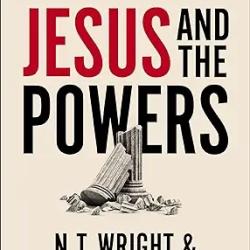Building on the seminal work of Richard Bauckham, Tom makes his case for adding to the picture by talking more specifically about the sort of eschatological fulfillment of the creational monotheism he sees as central to the way Paul reworked early Jewish monotheism. His essential premise is that far from taking intermediary figures and symbols using them as a basis to promote Jesus into the divine sphere, to the contrary, Paul takes images of God himself and applies them to Christ. Specifically he takes the Jewish question– What will it look like when God returns to Zion (and is once more king on the hill) and frees his people, and applies this to his analysis of the Incarnation, life, death and resurrection of Jesus. In Wright’s view all of that was the inauguration of the Kingdom of God on earth. He puts the matter succinctly: “Early christology did not begin…as a strange new belief based on memories of earlier Jewish language for mediator-figures, or even on the strong sense of Jesus’ personal presence during worship and prayer… The former was not… relevant,and the latter was…important but secondary. The most important thing was that in his life, death, and resurrection, Jesus had accomplished the new exodus, had done in person what Israel’s God said he would do in person. He had inaugurated God’s kingdom on earth as in heaven. Scholars have spent too long looking for pre-Christian Jewish ideas about human figures, angels, or other intermediaries. What matters is the pre-Christian Jewish ideas about Israel’s God. Jesus’ first followers found themselves not only…permitted to use God-language for Jesus, but compelled to use Jesus language for the one God. (pp. 654-55).
This analysis I think is essentially correct, though there is a bit of a problem of seeing the first coming of Jesus as the fulfillment of the Yom Yahweh traditions, since Jesus does not in fact take on the task of judging the world of human beings during his first coming. Indeed Mk. 14.62 suggests he associates it with a later event.
Tom then proceeds to walk through a demonstration of how the material in Sir. 24 and Wisdom of Solomon are used by Paul in his portrayal of the person and work of God’s Son, God’s Wisdom come in the flesh (pp. 655ff.). I am in agreement with him about the influence of these traditions being used by Paul, and as Tom says, they have to do with God himself, not with some lesser intermediaries. Wisdom personified is the Wisdom of the one God personified. It is not a reference to a second figure in heaven alongside the one God.
Less convincing is the argument on p. 658 which suggests that even with Ps. 2.7-8, “The phrase ‘son of God’ was not used in the pre-Christian Jewish world for anyone thought to be a human embodiment of Israel’s God.” (p. 658). While perhaps ‘human embodiment of Israel’s God’ is saying too much, nonetheless Ps. 2 seems to originally be part of a coronation ode for David the King, and we know for a fact that in the ANE anointed Kings were called the Son of some particular deity in a special sense, sometimes even suggesting some sort of quasi-divine status and power.
On pp. 658-61 Tom does a better job than heretofore in showing that the exodus and liberation from slavery theme undergirds key passages in Paul– Gal. 4.1-11, Rom. 8.1-4, 1 Cor. 8-10. This furthers his case for seeing the coming of Jesus as the return of God to his people, but what it does not further is his case that Jesus is seen as Israel herself as well. If Jesus is Wisdom, the rock, referred to in the Sinai wandering period (by which, Wright takes Paul to mean, God’s presence was with them), he is not the people themselves wandering in the wilderness. If Jesus is the creator and redeemer God, he is not also God’s people who were created and needed to be redeemed. In other words, the strong the case for the high christological reading of Paul’s Christ talk, the weaker the case for an ecclesiological reading of Jesus.
On p. 666 it is appropriate that Tom stresses that Jesus is not seen by Paul as a second God, “that would abrogate monotheism.” Paul says ‘For us there is One’. “To have said or implied, ‘For us there are Two’ would have meant ‘We are simply a new curiously restricted form of paganism, whereas throughout the letter [1 Corinthians is in view] is claiming to be standing on the ground of Jewish-style monotheism over against the pagan world.”
I am in total agreement with Tom that the crucifixion is at the very heart of the revelation of the character of the one true God (p. 667) “and that reflection must shine through the life of the community” for example in the commitment to self-sacrificial behavior by the strong in relationship to the weak. It is worth adding that if self-sacrifice, and more specifically self-sacrificial love is the epitome of the revelation God’s character, this presents a very different picture than the image of a narcissistic deity jealously guarding his glory, and being at his core self-referential in character.
p. 668 n. 157 provides ample references to show that ‘rock’ is a metaphor applied to God in the OT (and we might add to Wisdom in Wis. Sol. and similarly to Jesus in 1 Cor. 10). The treatment of the Christ hymn in Col. 1 on pp. 670-73 is very helpful, especially with the translation of prototokos as ‘and he is ahead’… coupled later with the phrase ‘He is the start of it all’, leaving out the confusing concept of birth, which has misled some to think Christ is seen as the first creature, rather than on the Creator side of the ledger. Interestingly, on p. 673, Tom relies on the older work of C.F. Burney on this material, helpfully showing the echoes of monotheistic language from the Shema in 1 Cor. 8.6 and elsewhere.













